2015 NISSAN LEAF warning
[x] Cancel search: warningPage 125 of 412

WARNING
• The front air bags ordinarily will not inflate in the event of a side impact,
rear impact, rollover or lower severity
frontal collision. Always wear your
seat belts to help reduce the risk or
severity of injury in various kinds of
accidents.
• The front passenger air bag will not inflate if the passenger air bag status
light is lit or if the front passenger seat
is unoccupied. See “Front passenger
air bag and status light” in this section.
•
The seat belts and the front air bags are
most effective when you are sitting well
back and upright in the seat with both
feet on the floor. The front air bags inflate
with great force. Even with the NISSAN
Advanced Air Bag System, if you are un-
restrained, leaning forward, sitting side-
ways or out of position in any way, you
are at greater risk of injury or death in a
crash. You may also receive serious or
fatal injuries from the front air bag if you
are up against it when it inflates. Always
sit back against the seatback and as far
away as practical from the steering wheel
or instrument panel. Always use the seat
belts.
• The driver and front passenger seat belt buckles are equipped with sen-
sors that detect if the seat belts are
fastened. The Advanced Air Bag Sys-
tem monitors the severity of a collision
and seat belt usage then inflates the
air bags as needed. Failure to properly
wear seat belts can increase the risk or
severity of injury in an accident.
• The front passenger seat is equipped with occupant classification sensors
(weight sensors) that turn the front
passenger air bag OFF under some
conditions. This sensor is only used in
this seat. Failure to be properly seated
and wearing the seat belt can increase
the risk or severity of injury in an acci-
dent. See “Front passenger air bag
and status light” in this section.
• Keep hands on the outside of the steering wheel. Placing them inside
the steering wheel rim could increase
the risk that they are injured if the front
air bag inflates.
1-38Safety–Seats, seat belts and supplemental restraint system
Page 126 of 412
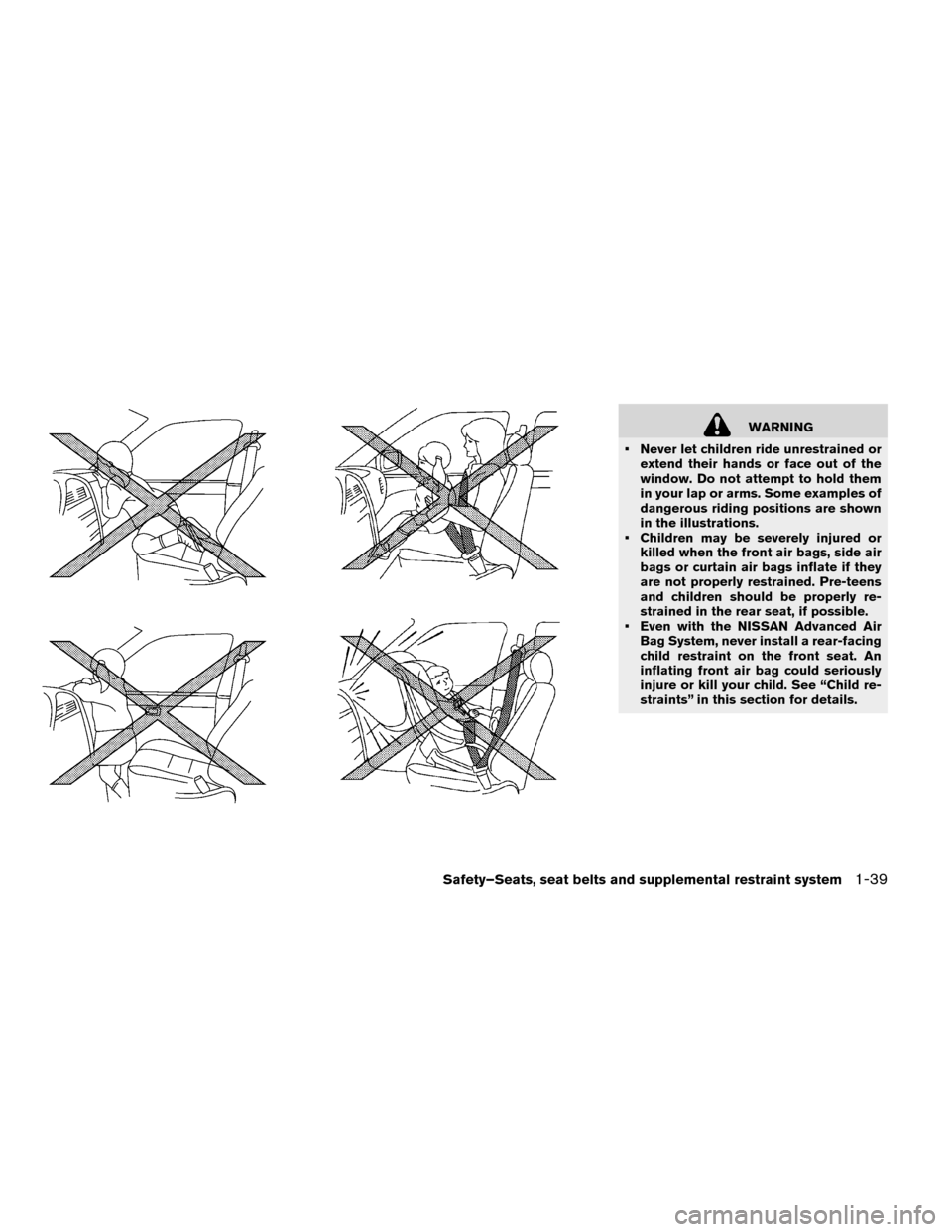
WARNING
• Never let children ride unrestrained or extend their hands or face out of the
window. Do not attempt to hold them
in your lap or arms. Some examples of
dangerous riding positions are shown
in the illustrations.
• Children may be severely injured or killed when the front air bags, side air
bags or curtain air bags inflate if they
are not properly restrained. Pre-teens
and children should be properly re-
strained in the rear seat, if possible.
• Even with the NISSAN Advanced Air Bag System, never install a rear-facing
child restraint on the front seat. An
inflating front air bag could seriously
injure or kill your child. See “Child re-
straints” in this section for details.
Safety–Seats, seat belts and supplemental restraint system1-39
Page 127 of 412
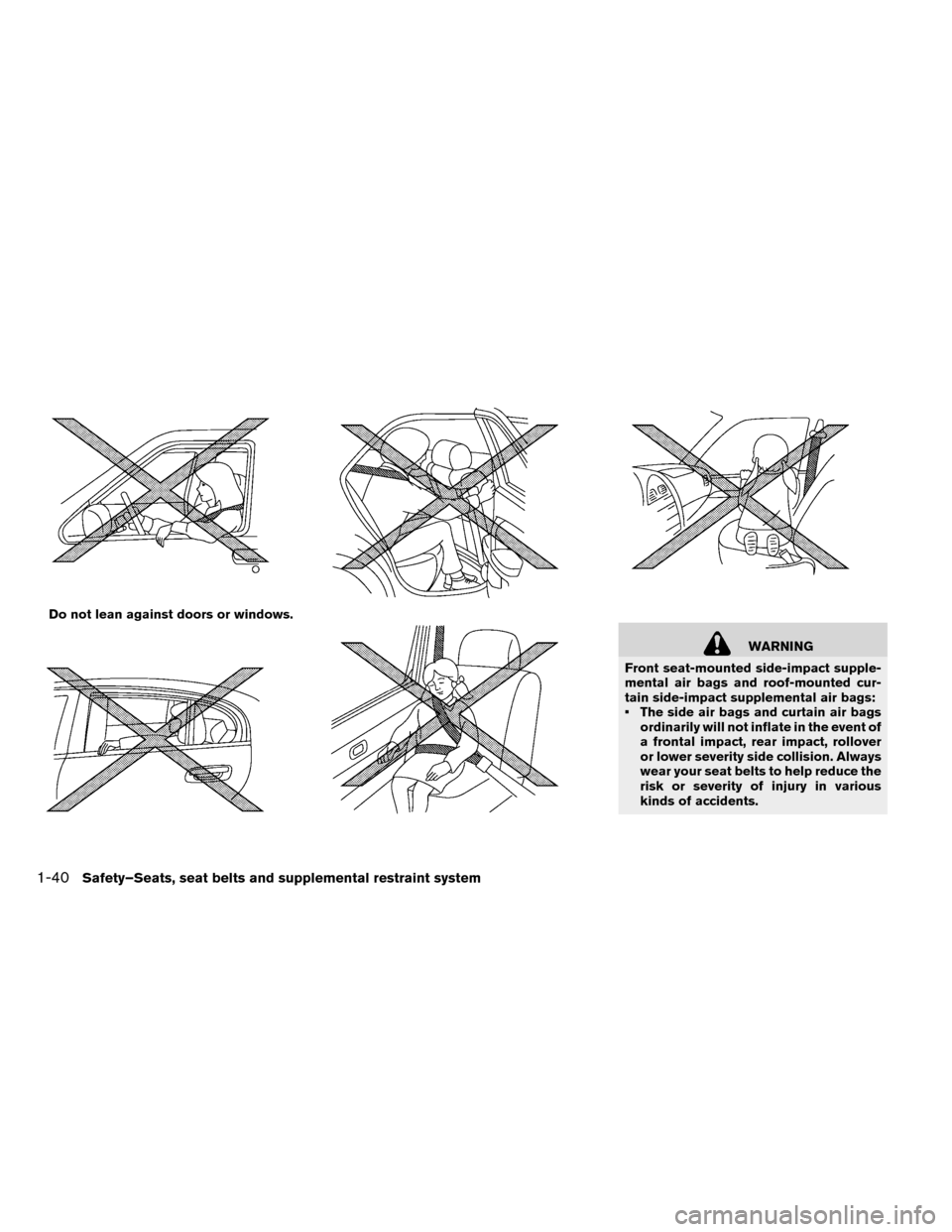
WARNING
Front seat-mounted side-impact supple-
mental air bags and roof-mounted cur-
tain side-impact supplemental air bags:
• The side air bags and curtain air bags ordinarily will not inflate in the event of
a frontal impact, rear impact, rollover
or lower severity side collision. Always
wear your seat belts to help reduce the
risk or severity of injury in various
kinds of accidents.
Do not lean against doors or windows.
1-40Safety–Seats, seat belts and supplemental restraint system
Page 129 of 412
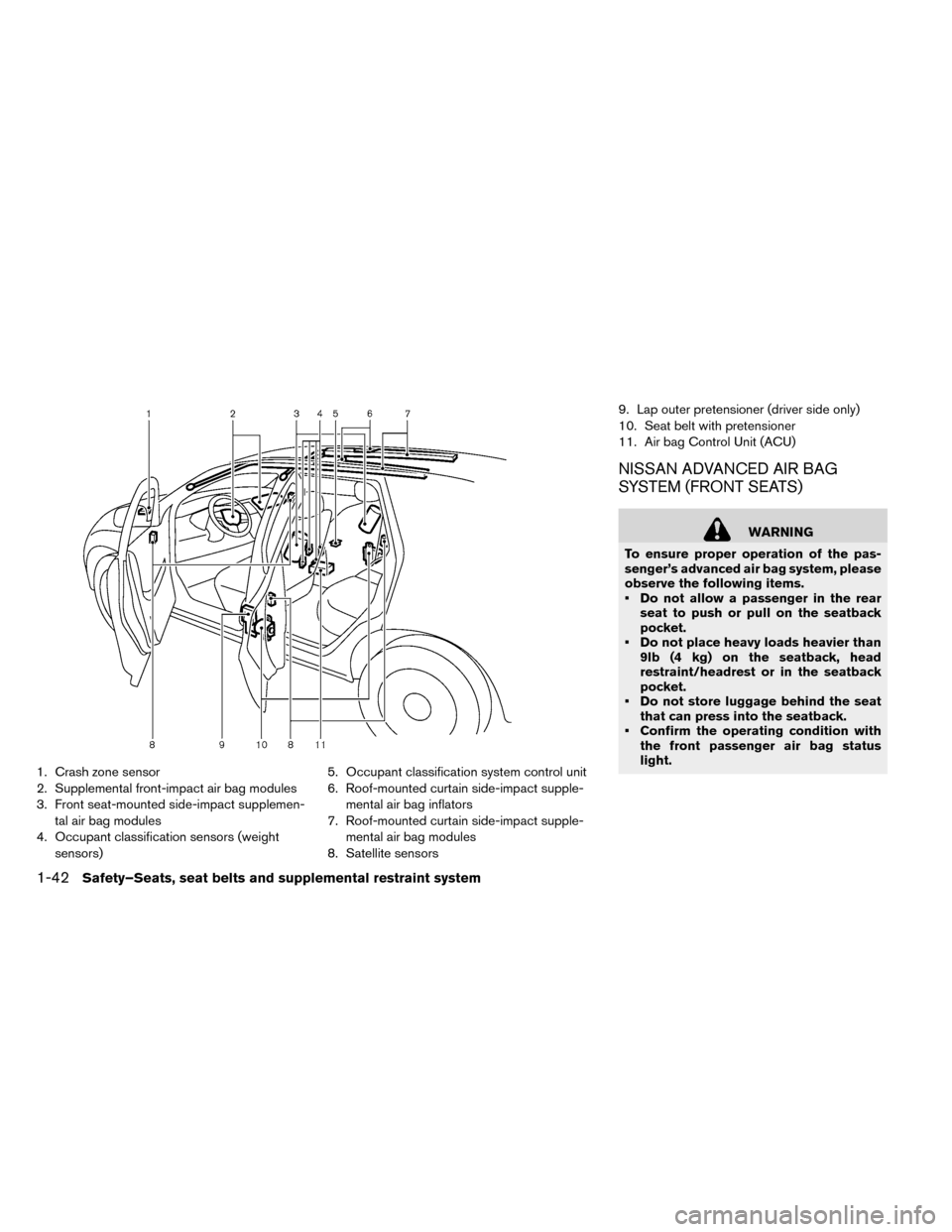
1. Crash zone sensor
2. Supplemental front-impact air bag modules
3. Front seat-mounted side-impact supplemen-tal air bag modules
4. Occupant classification sensors (weight sensors) 5. Occupant classification system control unit
6. Roof-mounted curtain side-impact supple-
mental air bag inflators
7. Roof-mounted curtain side-impact supple- mental air bag modules
8. Satellite sensors 9. Lap outer pretensioner (driver side only)
10. Seat belt with pretensioner
11. Air bag Control Unit (ACU)
NISSAN ADVANCED AIR BAG
SYSTEM (FRONT SEATS)
WARNING
To ensure proper operation of the pas-
senger’s advanced air bag system, please
observe the following items.
• Do not allow a passenger in the rear seat to push or pull on the seatback
pocket.
• Do not place heavy loads heavier than 9lb (4 kg) on the seatback, head
restraint/headrest or in the seatback
pocket.
• Do not store luggage behind the seat that can press into the seatback.
• Confirm the operating condition with the front passenger air bag status
light.
1-42Safety–Seats, seat belts and supplemental restraint system
Page 130 of 412
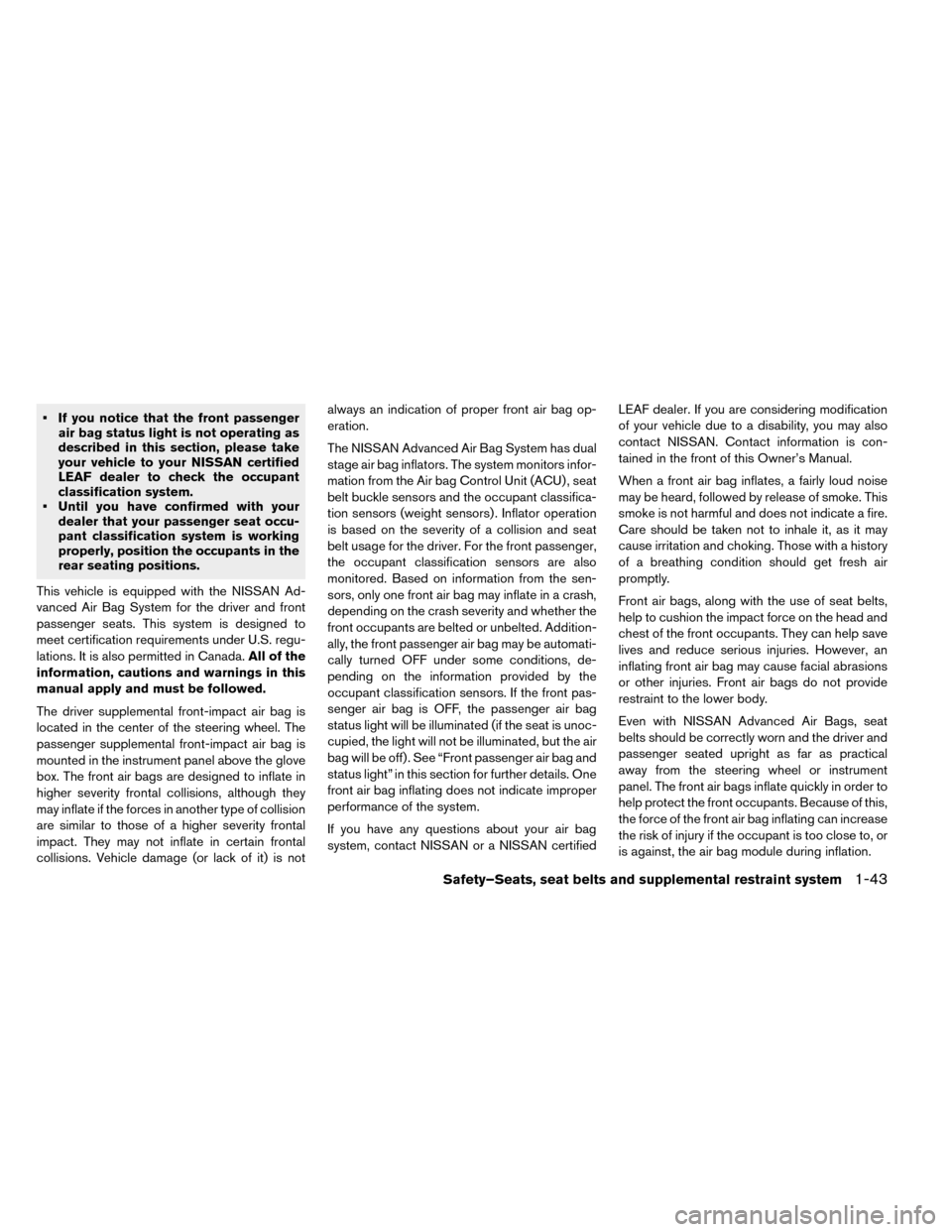
• If you notice that the front passengerair bag status light is not operating as
described in this section, please take
your vehicle to your NISSAN certified
LEAF dealer to check the occupant
classification system.
• Until you have confirmed with your dealer that your passenger seat occu-
pant classification system is working
properly, position the occupants in the
rear seating positions.
This vehicle is equipped with the NISSAN Ad-
vanced Air Bag System for the driver and front
passenger seats. This system is designed to
meet certification requirements under U.S. regu-
lations. It is also permitted in Canada. All of the
information, cautions and warnings in this
manual apply and must be followed.
The driver supplemental front-impact air bag is
located in the center of the steering wheel. The
passenger supplemental front-impact air bag is
mounted in the instrument panel above the glove
box. The front air bags are designed to inflate in
higher severity frontal collisions, although they
may inflate if the forces in another type of collision
are similar to those of a higher severity frontal
impact. They may not inflate in certain frontal
collisions. Vehicle damage (or lack of it) is not always an indication of proper front air bag op-
eration.
The NISSAN Advanced Air Bag System has dual
stage air bag inflators. The system monitors infor-
mation from the Air bag Control Unit (ACU) , seat
belt buckle sensors and the occupant classifica-
tion sensors (weight sensors) . Inflator operation
is based on the severity of a collision and seat
belt usage for the driver. For the front passenger,
the occupant classification sensors are also
monitored. Based on information from the sen-
sors, only one front air bag may inflate in a crash,
depending on the crash severity and whether the
front occupants are belted or unbelted. Addition-
ally, the front passenger air bag may be automati-
cally turned OFF under some conditions, de-
pending on the information provided by the
occupant classification sensors. If the front pas-
senger air bag is OFF, the passenger air bag
status light will be illuminated (if the seat is unoc-
cupied, the light will not be illuminated, but the air
bag will be off) . See “Front passenger air bag and
status light” in this section for further details. One
front air bag inflating does not indicate improper
performance of the system.
If you have any questions about your air bag
system, contact NISSAN or a NISSAN certified
LEAF dealer. If you are considering modification
of your vehicle due to a disability, you may also
contact NISSAN. Contact information is con-
tained in the front of this Owner’s Manual.
When a front air bag inflates, a fairly loud noise
may be heard, followed by release of smoke. This
smoke is not harmful and does not indicate a fire.
Care should be taken not to inhale it, as it may
cause irritation and choking. Those with a history
of a breathing condition should get fresh air
promptly.
Front air bags, along with the use of seat belts,
help to cushion the impact force on the head and
chest of the front occupants. They can help save
lives and reduce serious injuries. However, an
inflating front air bag may cause facial abrasions
or other injuries. Front air bags do not provide
restraint to the lower body.
Even with NISSAN Advanced Air Bags, seat
belts should be correctly worn and the driver and
passenger seated upright as far as practical
away from the steering wheel or instrument
panel. The front air bags inflate quickly in order to
help protect the front occupants. Because of this,
the force of the front air bag inflating can increase
the risk of injury if the occupant is too close to, or
is against, the air bag module during inflation.
Safety–Seats, seat belts and supplemental restraint system1-43
Page 131 of 412
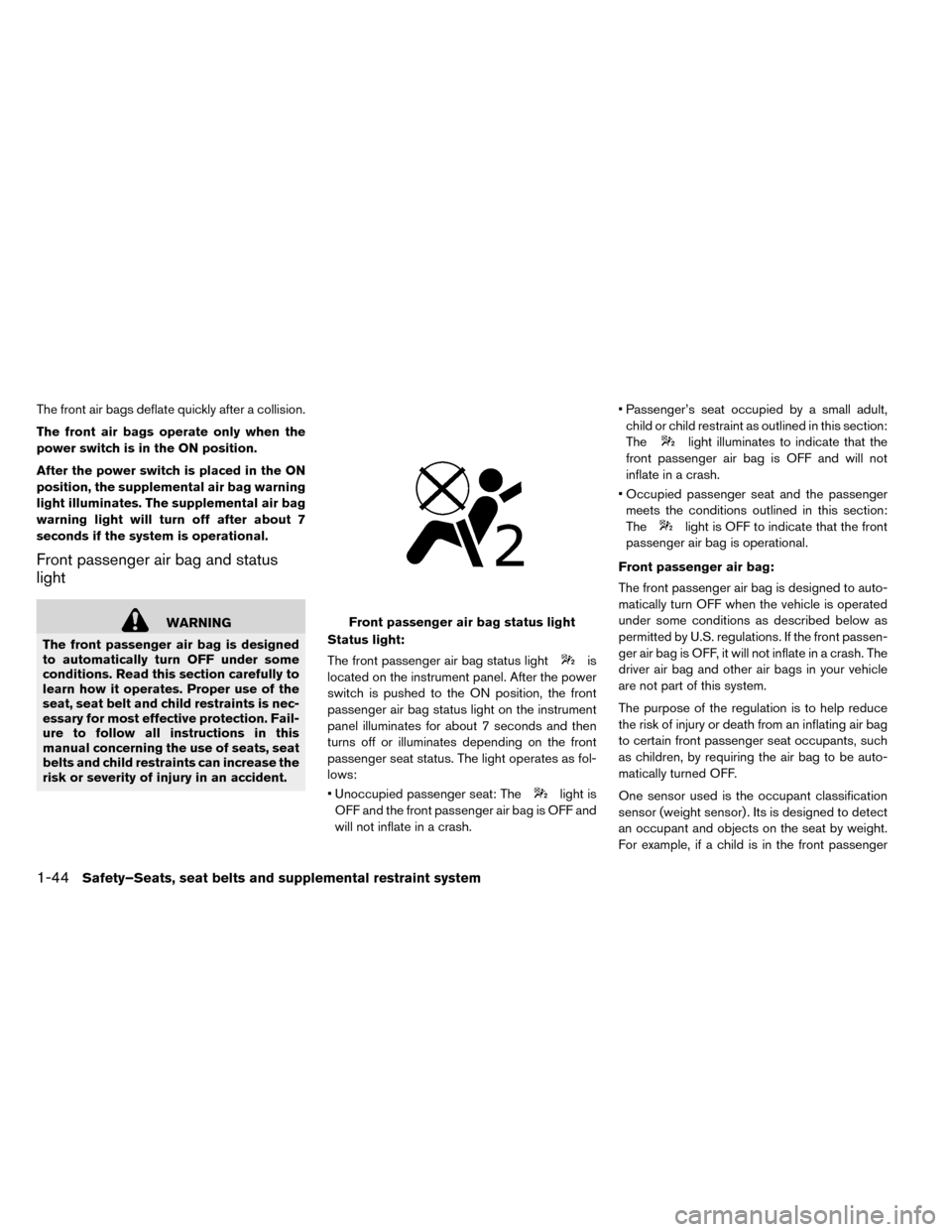
The front air bags deflate quickly after a collision.
The front air bags operate only when the
power switch is in the ON position.
After the power switch is placed in the ON
position, the supplemental air bag warning
light illuminates. The supplemental air bag
warning light will turn off after about 7
seconds if the system is operational.
Front passenger air bag and status
light
WARNING
The front passenger air bag is designed
to automatically turn OFF under some
conditions. Read this section carefully to
learn how it operates. Proper use of the
seat, seat belt and child restraints is nec-
essary for most effective protection. Fail-
ure to follow all instructions in this
manual concerning the use of seats, seat
belts and child restraints can increase the
risk or severity of injury in an accident. Status light:
The front passenger air bag status light
is
located on the instrument panel. After the power
switch is pushed to the ON position, the front
passenger air bag status light on the instrument
panel illuminates for about 7 seconds and then
turns off or illuminates depending on the front
passenger seat status. The light operates as fol-
lows:
• Unoccupied passenger seat: The
light is
OFF and the front passenger air bag is OFF and
will not inflate in a crash. • Passenger’s seat occupied by a small adult,
child or child restraint as outlined in this section:
The
light illuminates to indicate that the
front passenger air bag is OFF and will not
inflate in a crash.
• Occupied passenger seat and the passenger meets the conditions outlined in this section:
The
light is OFF to indicate that the front
passenger air bag is operational.
Front passenger air bag:
The front passenger air bag is designed to auto-
matically turn OFF when the vehicle is operated
under some conditions as described below as
permitted by U.S. regulations. If the front passen-
ger air bag is OFF, it will not inflate in a crash. The
driver air bag and other air bags in your vehicle
are not part of this system.
The purpose of the regulation is to help reduce
the risk of injury or death from an inflating air bag
to certain front passenger seat occupants, such
as children, by requiring the air bag to be auto-
matically turned OFF.
One sensor used is the occupant classification
sensor (weight sensor) . Its is designed to detect
an occupant and objects on the seat by weight.
For example, if a child is in the front passenger
Front passenger air bag status light
1-44Safety–Seats, seat belts and supplemental restraint system
Page 133 of 412
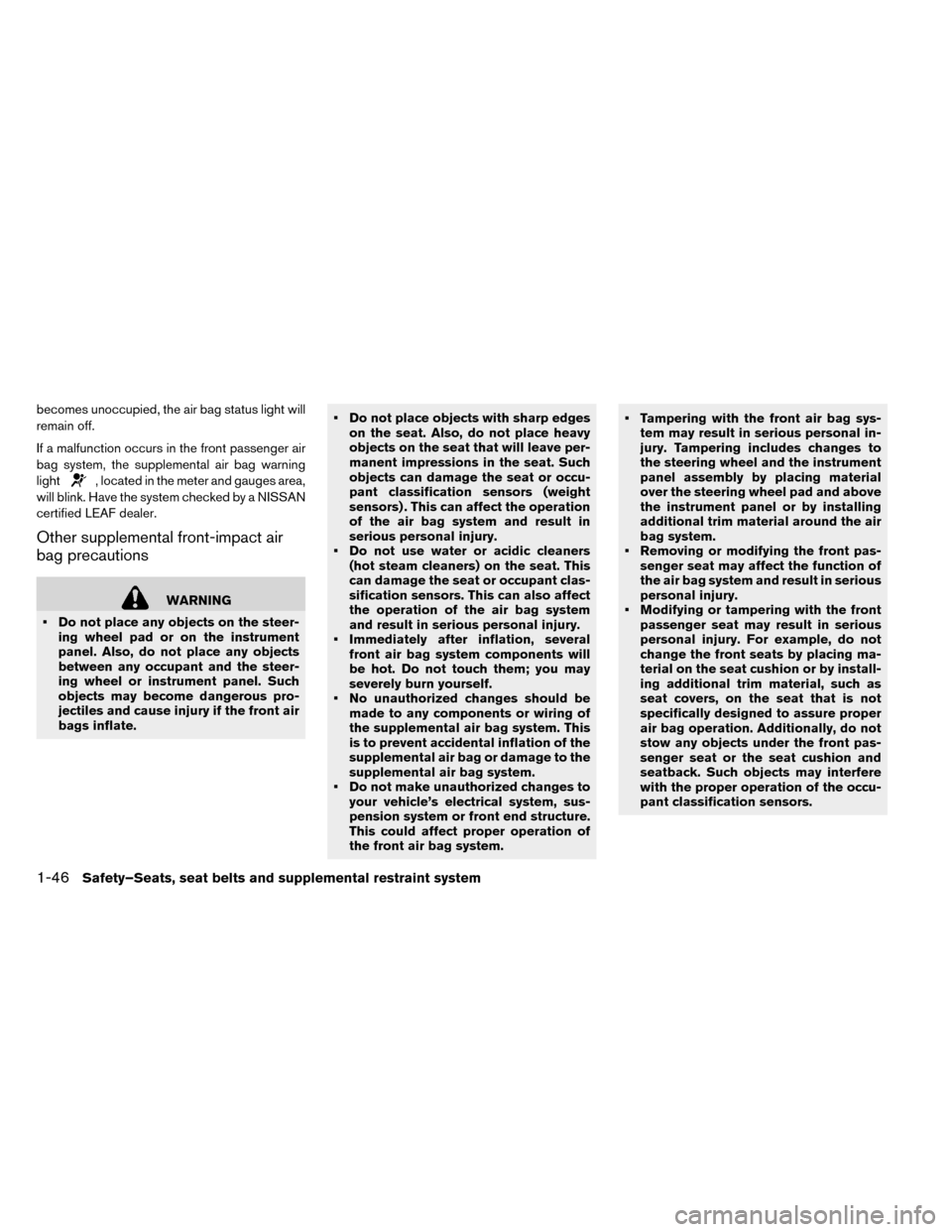
becomes unoccupied, the air bag status light will
remain off.
If a malfunction occurs in the front passenger air
bag system, the supplemental air bag warning
light
, located in the meter and gauges area,
will blink. Have the system checked by a NISSAN
certified LEAF dealer.
Other supplemental front-impact air
bag precautions
WARNING
• Do not place any objects on the steer- ing wheel pad or on the instrument
panel. Also, do not place any objects
between any occupant and the steer-
ing wheel or instrument panel. Such
objects may become dangerous pro-
jectiles and cause injury if the front air
bags inflate. • Do not place objects with sharp edges
on the seat. Also, do not place heavy
objects on the seat that will leave per-
manent impressions in the seat. Such
objects can damage the seat or occu-
pant classification sensors (weight
sensors) . This can affect the operation
of the air bag system and result in
serious personal injury.
• Do not use water or acidic cleaners (hot steam cleaners) on the seat. This
can damage the seat or occupant clas-
sification sensors. This can also affect
the operation of the air bag system
and result in serious personal injury.
• Immediately after inflation, several front air bag system components will
be hot. Do not touch them; you may
severely burn yourself.
• No unauthorized changes should be made to any components or wiring of
the supplemental air bag system. This
is to prevent accidental inflation of the
supplemental air bag or damage to the
supplemental air bag system.
• Do not make unauthorized changes to your vehicle’s electrical system, sus-
pension system or front end structure.
This could affect proper operation of
the front air bag system. • Tampering with the front air bag sys-
tem may result in serious personal in-
jury. Tampering includes changes to
the steering wheel and the instrument
panel assembly by placing material
over the steering wheel pad and above
the instrument panel or by installing
additional trim material around the air
bag system.
• Removing or modifying the front pas- senger seat may affect the function of
the air bag system and result in serious
personal injury.
• Modifying or tampering with the front passenger seat may result in serious
personal injury. For example, do not
change the front seats by placing ma-
terial on the seat cushion or by install-
ing additional trim material, such as
seat covers, on the seat that is not
specifically designed to assure proper
air bag operation. Additionally, do not
stow any objects under the front pas-
senger seat or the seat cushion and
seatback. Such objects may interfere
with the proper operation of the occu-
pant classification sensors.
1-46Safety–Seats, seat belts and supplemental restraint system
Page 134 of 412
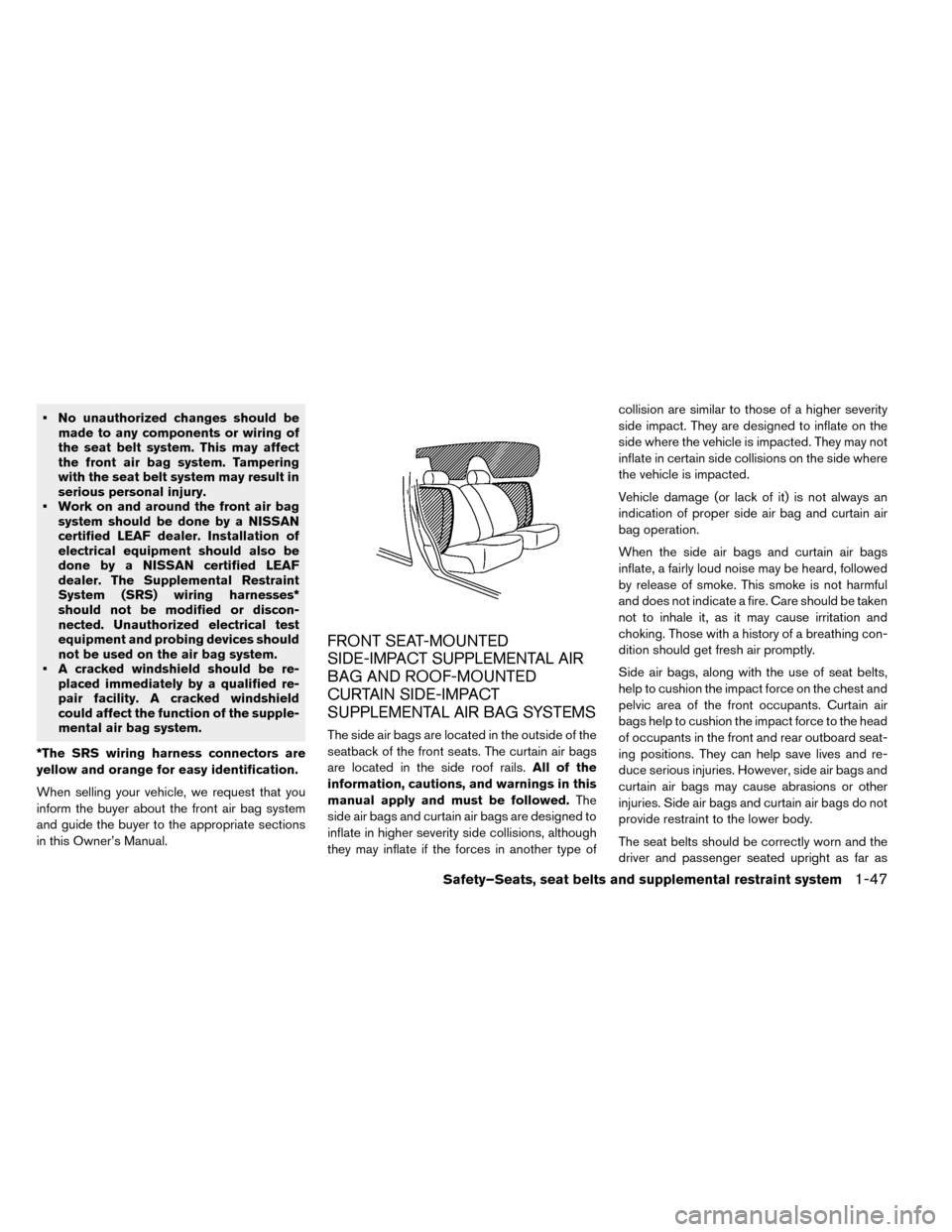
• No unauthorized changes should bemade to any components or wiring of
the seat belt system. This may affect
the front air bag system. Tampering
with the seat belt system may result in
serious personal injury.
• Work on and around the front air bag system should be done by a NISSAN
certified LEAF dealer. Installation of
electrical equipment should also be
done by a NISSAN certified LEAF
dealer. The Supplemental Restraint
System (SRS) wiring harnesses*
should not be modified or discon-
nected. Unauthorized electrical test
equipment and probing devices should
not be used on the air bag system.
• A cracked windshield should be re- placed immediately by a qualified re-
pair facility. A cracked windshield
could affect the function of the supple-
mental air bag system.
*The SRS wiring harness connectors are
yellow and orange for easy identification.
When selling your vehicle, we request that you
inform the buyer about the front air bag system
and guide the buyer to the appropriate sections
in this Owner’s Manual.
FRONT SEAT-MOUNTED
SIDE-IMPACT SUPPLEMENTAL AIR
BAG AND ROOF-MOUNTED
CURTAIN SIDE-IMPACT
SUPPLEMENTAL AIR BAG SYSTEMS
The side air bags are located in the outside of the
seatback of the front seats. The curtain air bags
are located in the side roof rails. All of the
information, cautions, and warnings in this
manual apply and must be followed. The
side air bags and curtain air bags are designed to
inflate in higher severity side collisions, although
they may inflate if the forces in another type of collision are similar to those of a higher severity
side impact. They are designed to inflate on the
side where the vehicle is impacted. They may not
inflate in certain side collisions on the side where
the vehicle is impacted.
Vehicle damage (or lack of it) is not always an
indication of proper side air bag and curtain air
bag operation.
When the side air bags and curtain air bags
inflate, a fairly loud noise may be heard, followed
by release of smoke. This smoke is not harmful
and does not indicate a fire. Care should be taken
not to inhale it, as it may cause irritation and
choking. Those with a history of a breathing con-
dition should get fresh air promptly.
Side air bags, along with the use of seat belts,
help to cushion the impact force on the chest and
pelvic area of the front occupants. Curtain air
bags help to cushion the impact force to the head
of occupants in the front and rear outboard seat-
ing positions. They can help save lives and re-
duce serious injuries. However, side air bags and
curtain air bags may cause abrasions or other
injuries. Side air bags and curtain air bags do not
provide restraint to the lower body.
The seat belts should be correctly worn and the
driver and passenger seated upright as far as
Safety–Seats, seat belts and supplemental restraint system1-47